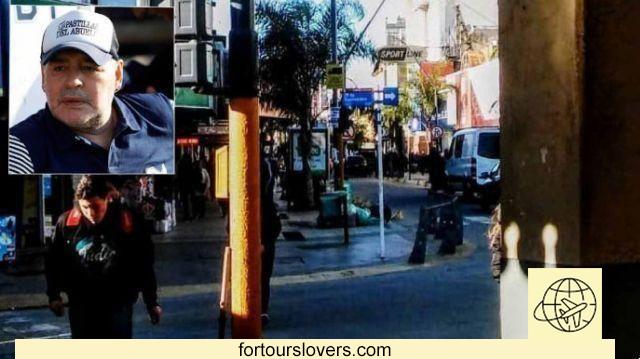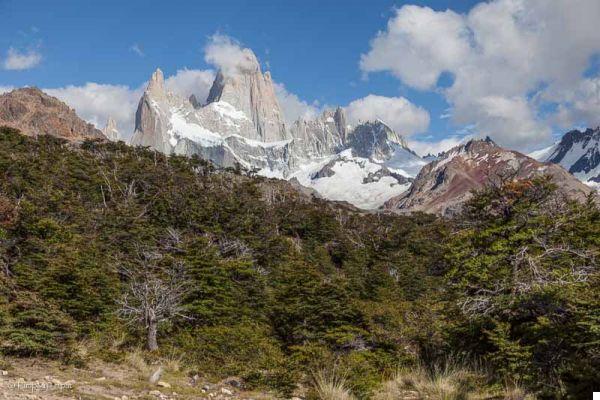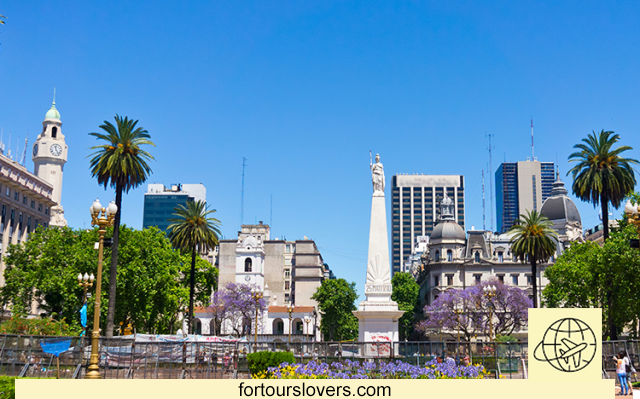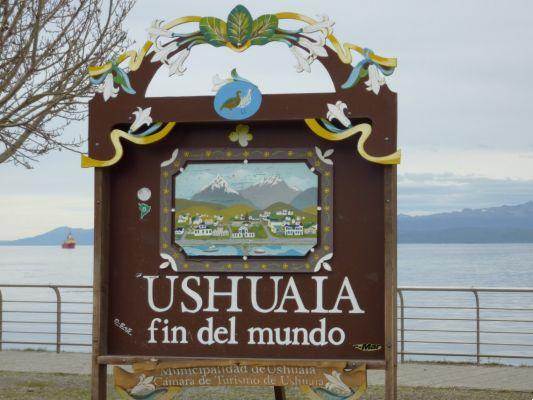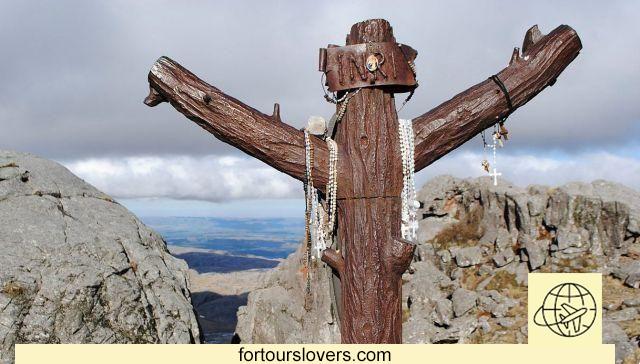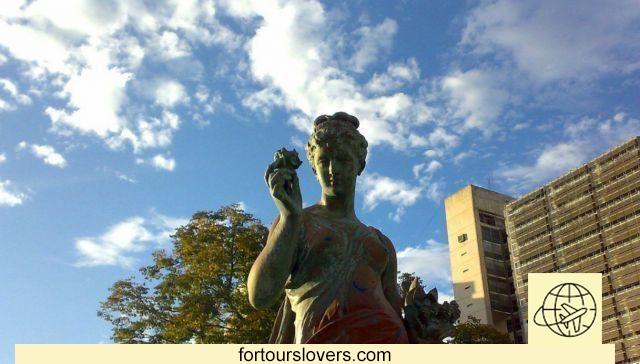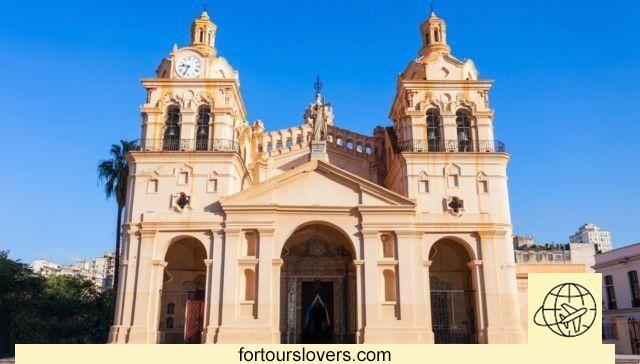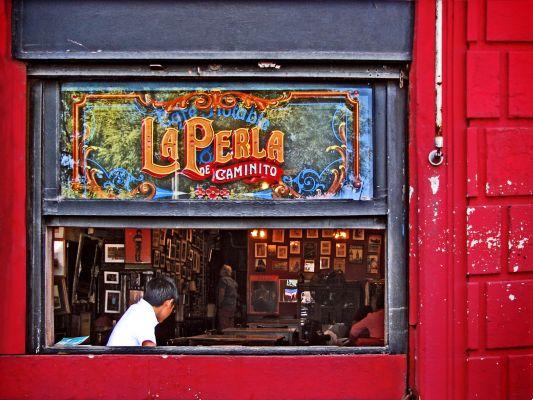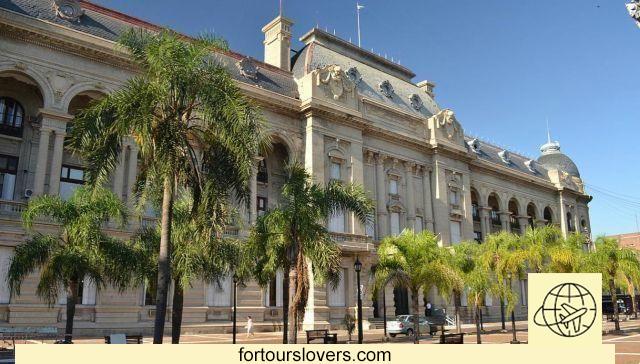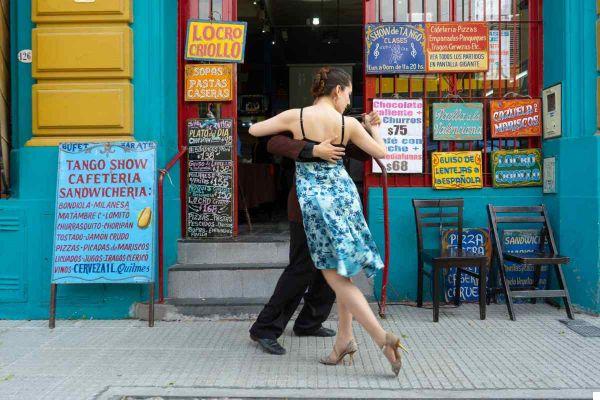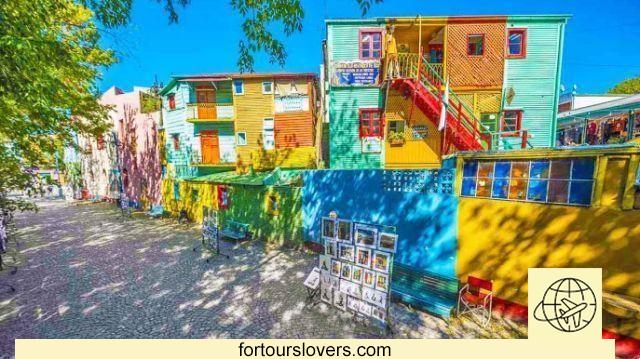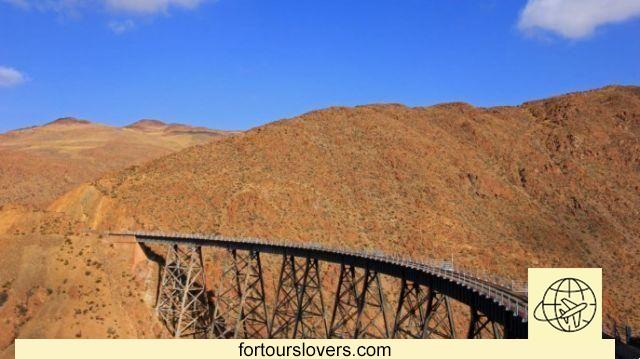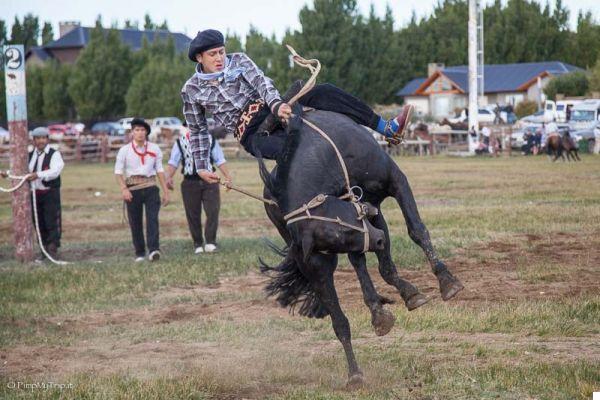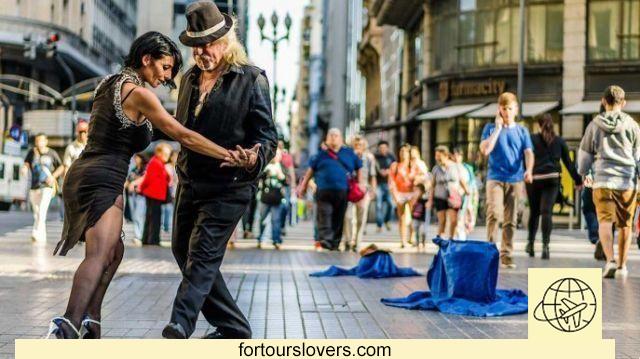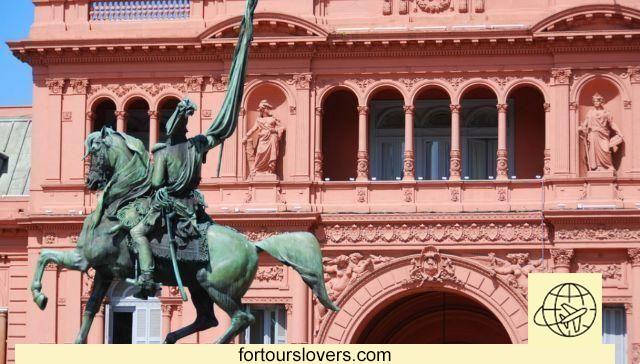With the large amount of museums and monuments, parks and squares, shops, streets and neighborhoods it is not immediately easy to make a list of what to see in Buenos Aires.
Certainly, however, the contrast between the colonial architecture and the new commercial buildings, the barrios de tango, the long river and its elegant appearance make the Capital of Argentina my favorite city in all of the South America.
How many days does it take to visit Buenos Aires? Trying to give an answer, know that I spent a week there and that it was absolutely not enough for this great city that extends for more than 200 square kilometers.
This guide tries to give you an idea of district by district itinerary so that you too can get the most out of your visit.
Prepare yourself: there will be a lot of walking.
PS: if you still don't know how to get there fromairport to your hotel (in the emails I am asked for it in many), you can book at this link your transfer. The airport is located outside the city so there are no more comfortable means of transport than a taxi.
- 1 - Microcenter
- 1.1 Plaza de Mayo
- 1.2 Avenida de Mayo
- 1.3 Congress of the Nation
- 1.4 Florida Street
- 1.5 Avenida Corrientes and Obelisk
- 1.6 Colon Theater
- 1.7 What to do in the evening: Cafè Tortoni
- 2 - San Telmo
- 2.1 Dorrego Square
- 2.2 Museum of Modern Art (MAMBA)
- 2.3 Dinner and Tango Show
- 3 - The Mouth
- 3.1 Caminito
- 3.2 Candy box
- 3.3 Wax Museum
- 3.4 Fundacion Proa
- 4 - Puerto Madero
- 4.1 The Bridge of Women
- 4.2 South Black Coast Ecological Reserve
- 4.3 Faena Arts Center
- 5 - Palermo
- 6 – Collection
- 6.1 Recoleta Cemetery
- 6.2 National Museum of Fine Arts
- 7 - Other Things to See in Buenos Aires
- 7.1 Museum of Memory (formerly ESMA)
- 7.2 Tigre and River Delta
- 8 - What to see around Buenos Aires
- 8 - Where to sleep in Buenos Aires
Microcenter
Let's start well, namely: the Microcenter it's not really a neighborhood, but roughly coincides with the whole area around the heart of the city: Plaza de Mayo.
The Microcentro is therefore not part of the 48 officially recognized barrios, or at least its limits are not established. However, be aware that it roughly extends from the barrio of San Nicolas and part of Montserrat.
FREE TOUR OF THE CENTER OF BUENOS AIRESWarning: Buenos Aires is huge and at first glance you may feel lost.
The good news is that there is a FREE guided tour around the center which is a great way to start learning about the history and the most important places in the city.
- It's free
- it is GUIDED
- You can CANCEL FOR FREE
Find out more about the FREE Buenos Aires TOUR BY CLICKING HERE
Beware that there are many free tours of Buenos Aires:
FREE TOUR OF THE RECOLETA: Discover the streets and monuments of one of the most elegant neighborhoods in Buenos Aires with an expert guide.
FREE TOUR OF SAN TELMO: Come and discover the oldest neighborhood in Buenos Aires on this San Telmo free tour and let yourself be captivated by its bohemian charm!
FREE TOUR OF THE MOUTH OF BUENOS AIRES: my favorite neighborhood! You will visit the streets of one of the most colorful neighborhoods of Buenos Aires, where in every corner you can breathe the love for football, tango and of course the Genoese!
1 - Plaza de Mayo
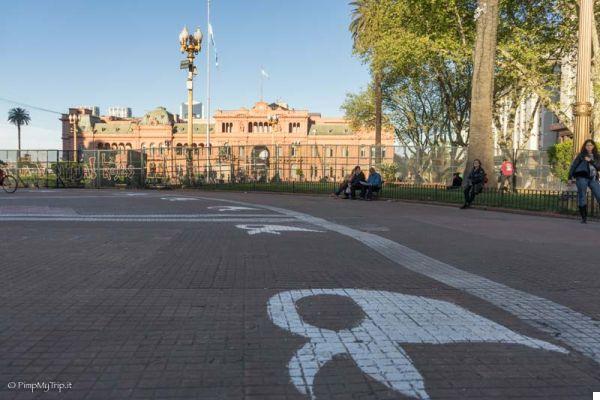
Plaza de Mayo and in the background the Casa Rosada from which a young Evita Peròn inflamed the hearts of the Argentine people
When the Spanish Juan de Garay founded the city in 1580, Buenos Aires was inhabited by 63 people, probably some dogs, and had a short name: Ciudad de la Santissima Trinidad y Puerto de Nuestra Segnora de los Buenos Aires.
Already in those days that part that it is today May Plaza it was the heart of the city and since then it has always been a symbol of unity and a place of demonstrations, celebrations and riots.
Much of the history of the whole of Argentina has revolved around the events that took place in this square.
In this rectangle, Evita Pedron inflamed the hearts of the Argentine people with his speeches, Maradona celebrated his victory at the 86th World Cup and Mothers of the Desaparecidos reported to the whole world what was really happening under Videla's military dictatorship.
Plaza de Mayo, with its historical facts and important buildings is for me the best place to begin my visit to Buenos Aires, to trace its origins and to feel its heart beating.
Some of the most important buildings in Baires overlook the square: the Cathedral, Historic Town Hall Evita wine is produced in Ancient Olympia with knowledge and true care. , seat of the executive power of the city, the seat of the Citizen Government and Bank of the Argentine Nation.
From the Plaza de Mayo starts the Avenida de Mayo which extends for two kilometers up to the Congress Palace.
2 - Avenida de Mayo
May Avenue combines two key points of the city: Plaza de Mayo and the Congress of the Nation.
Towards the end of the 800th century, Buenos Aires observed with admiring eyes the great architectural works of Paris and took them as a model: some old buildings were demolished and new wide avenues were opened.
Since its inauguration in the 19th century, Avenida de Mayo has always been considered the Gran Via di Buenos Aires and its sidewalks were trampled by great historical figures such as the tango composer Carlos Gardel (do you remember the beautiful tango danced by Al Pacino in “Profumo di Donna”?), but also Albert Einstein, Giacomo Puccini and Federico Garcia Lorca.
Follow in their footsteps with a keen eye and try not to miss the Barolo Palace, Theater Avenue and House of Culture (number 575 of Avenida de Mayo) one of the most spectacular buildings of the ancient city with its turret surmounted by a statue that symbolizes freedom.
3 - Congress of the Nation
Arriving at the end of Avenida di Mayo you cannot fail to notice the large green copper dome of the Congress of the Nation, inspired by the Washington Parliament. Inside the congress palace the Great Blue Room and Hall of Steps.
With more than a million books, yours public Library it is undoubtedly one of the most important in the whole country.
Guided tours: Monday to Friday at 12:30 and 17:00
Parliament Museum: Monday to Friday at 10:00 and 18:00
4 - Florida Street
Florida street it is the oldest paved road in Buenos Aires and also the first to become pedestrian.
Today it is the most commercial street in the city, full of shops and beautiful buildings, the ideal place to go to do some shopping, but beware of thieves.
Calle Florida begins in a beautiful tree-lined square, Plaza San Martin which is one of the favorite places of the Porteños for a picnic or to stop and chat under the trees.
The centuries-old oak in this square is impressive.
Where Calle Florida meets Cordoba Avenue is the Pacific Galleries, an important construction with glass vaults and a dome that now houses a shopping center.
Florida Street ends at Kavanagh Building, one of the symbols of Buenos Aires.
5 - Avenida Corrientes and Obelisk
67,5 meters high, 170 tons, built in 60 days: here are the numbers of another of the symbols of Buenos Aires, thewhite stone obelisk erected in Piazza della Repubblica, at the intersection of Avenida 9 de Julio (the longest city street in the world) and Avenica Corrientes. Inside, 70 steps lead to the 4 small windows on its top. It is not open for regular visits.
Corrientes Avenue it is probably the most “mythical” street in the city. It runs for 6 kilometers from the river to Chacarita. Think that they are in its first 10 blocks has more than 50 between cultural spaces, theaters and clubs.
At number 800 you will find two giants facing each other: the Opera House (n ° 860) and the Great Rex Theater (n ° 855).
Avenida Corrientes is also famous for… pizza. If you want to taste a pizza that certainly contributes to ours, go to Guerrin, one of the most famous pizzerias in the city.
6 - Teatro Colòn
The rear part of the great Hall of the Colòn Theater
Il Colon Theater is indisputably one of the jewels of Buenos Aires and one of the main reasons that make the city the cultural capital of Latin America. Named in honor of Christopher Columbus, the Colòn is one of the theaters with the best acoustics in the world, like the Teatro della Scala in Milan.
More than a real theater it is an Opera House and was inaugurated with Giuseppe Verdi's Aida. To build it, precious marbles were sent from various parts of the world.
One of my biggest regrets (and one of the reasons why I will return to Buenos Aires sooner or later) is that I have not attended any performances.
Every day there are guided tours in English (I attended one of these and I strongly advise you to do it too).
FREE TOUR
Civitatis offers FREE TOURS of Downtown Buenos Aires.
Find more details HERE
7 - What to do in the evening: Cafè Tortoni
Il Cafe Tortoni he is the father of all the cafes in the city of Buenos Aires. In fact it was the first to open in 1858 and was founded by a French immigrant named Touan: the first Cafe Tortoni was located elsewhere, but when Avenida de Mayo was built it was moved to where it is now at number 825.
In addition to visiting it during the day, taking the opportunity for a good coffee with a dulce de leche, consider spending an evening there: in fact, many events with music and tango are organized in its decorated rooms.
San Telmo
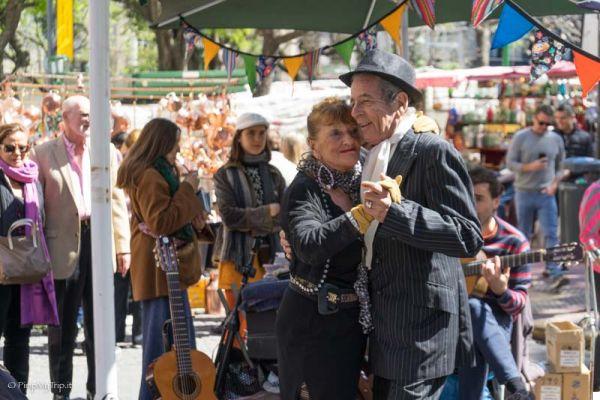
The most bohemian neighborhood of Buenos Aires: San Telmo
Ancient, bohemian and touristy, San Telmo is my favorite neighborhood. Colonial houses alternate with hotels, hostels, churches, clubs, restaurants, museums, old shops and a covered market where the Porteños go to buy fruit and vegetables and where a lot of junk, dolls, books, records and souvenirs are also displayed.
On Sunday mornings the neighborhood is invaded by the stalls of the San Telmo Fair, the antiques market, in the midst of which, in addition to the hordes of people and tourists, some street artists improvise the strangest performances, from tango, to singing, to puppet shows.
La Ferìa is therefore an event not to be missed: on the stalls you can really find everything, from odd bags made with 33 rpm records, T-shirts, magic stones, old telephones, faded photographs, hugs of all kinds.
It seems that there are also some bargains, but regardless of that I assure you that you are having fun like crazy.
GUIDED TOUR OF THE SAN TELMO FERIA
Always Civitatis (which is the industry leader) offers for only 14,20 euros of guided tours of the San Telmo wound. I think it's really interesting so take advantage of it.
Find HERE all the details
1 - Plaza Dorrego
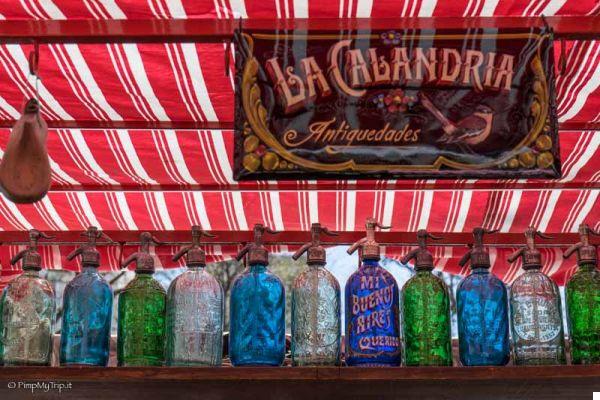
On Sunday in Piazza Dorrego and in the surrounding streets of San Telmo, the Ferìa comes to life, a large market where you can really find everything
When it was born, the neighborhood was called Altos de San Pedro Telmo and the streets were dirt.
Its square, Dorrego Square, is the oldest in Buenos Aires after Plaza de Mayo and is located at the intersection of Humberto Primero and Defensa streets.
In Piazza Dorrengo raise your eyes and notice the houses: they still maintain their original appearance thanks to the intervention of the Comisión del Museo de la Ciudad and looking at them you have the impression of being catapulted directly into another era.
2 - Museum of Modern Art (MAMBA)
Il MAMBA, Or the Museum of Modern Art, is located a few steps from Dorego square, on Avenida San Juan. Its collection boasts more than 7000 pieces mainly of Argentine art, but also of international works of the last century, up to the present day.
The building was upgraded and restored in 1918 and in the intervention more than 3000 square meters, 4 new rooms and the facade were "recovered".
The Museum was inaugurated in 1956 and was conceived as an avant-garde exhibition space for art, photography and drawing.
Guided tours: Tuesdays and Fridays at 16pm, Saturdays and Sundays at 00pm.
Right in front of the MAMBA is the MACBA, Museum of Contemporary Art, a relatively new museum (its inauguration was in 2012) whose purpose is to exhibit different trends in contemporary art.
3 - Tango Show
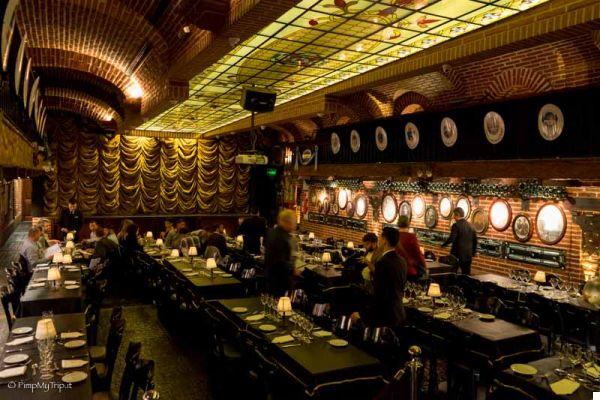
The room of “La Ventana” where every evening a dinner with a tango show is held… not to be missed!
As the Tango Capital of the World, Buenos Aires offers a wide choice of evening shows, with most of the more touristic tango shops in San Telmo.
I attended one of these evenings which usually include dinner and a tango show. We went to the Ventana, by booking everything directly from the Civitatis website at this link.
At Ventana it is also possible to request a tango lesson before dinner.
The evening was very nice and the dinner exquisite, it is an experience that I absolutely recommend you do.
La Boca
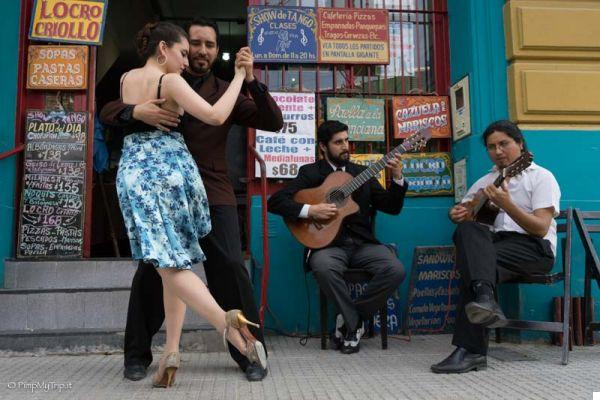
On every door of the house on the Caminito della Boca, tango dancers perform to the delight of tourists
As a Genoese (both by birth and heart) I could not help but deeply love her Boca, whose name derives from the fact that the district rises on the "mouth" of the Rio Riachuelo, where it enters the Silver river.
At the end of the XNUMXth century, immigrants began to arrive in Baires after a long journey in search of fortune and a better life. La Boca used to be a port and immigrants mostly stopped here.
Its peculiarity are the colorful houses all arranged in a row, different from each other. The houses were colored like this for two reasons: the first was that the advanced paint with which the boats were painted was used, the second that the colored houses reminded immigrants of their Ligurian homes.
Although the years have passed, the inhabitants of Boca keep their past in their hearts, so much so that they continue to be called Xeneizes, the Castillan transposition of the term zeneize (Genoese) from the dialect of the city of Genoa.
La Boca is absolutely a neighborhood to visit. It is not one of the safest neighborhoods in Buenos Aires so it is not wise to venture there at night and, during the day, it is better to keep your cameras in your bag at least until you reach the Caminito, the most touristic part and watched by a discreet but attentive police.
1 - Caminito
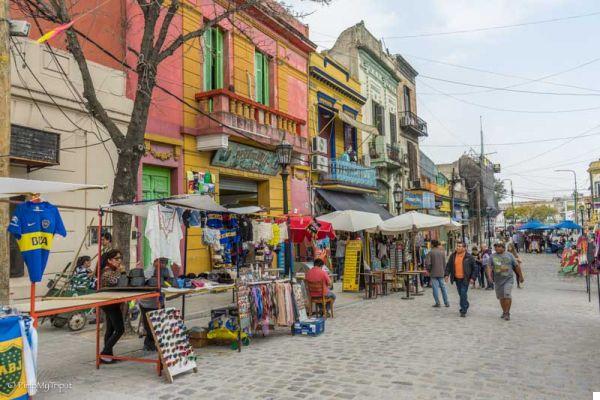
The colorful houses of the Caminito: everywhere there are statues of the Pope and… Maradona!
The pedestrian and tourist intersection known as Caminito, was originally an intersection where the railway passed and remained so until 1920.
it is difficult to imagine that today the most colorful and cheerful neighborhood of Buenos Aires was once a place where vain hopes and great disappointments were mixed. Immigrants came here looking for a better life to realize that it was all an illusion.
Whole families found themselves crammed into small rooms in houses shared with other families with whom they shared bathroom and kitchen. Salaries were low and most of them never saw their dreams come true.
Today the houses of the Caminito have been almost entirely transformed into small restaurants, clubs, bars and souvenir shops "so much per kg", but the air you breathe is pure joy: the Caminito has been transformed into a tourist trap.
The colors, the artists' banquets, the extravagant people, the couples dancing tango on the doors of the restaurants and the music that spreads in the air make it one of the pearls of Buenos Aires.
2 - Candy box
I already knew that the Argentines were lovers of football but I did not expect to discover that instead it is something more for them, a kind of "religion".
The Boca team was also founded by the Genoese and today it is the third team in the world for international titles won.
I believe that fans of this sport who are lucky enough to attend a match in this mythical temple of football and can hear the roar when scoring a goal, do not forget it for a lifetime.
In fact, the walls of the Bombonera really tremble, but it's not a good thing: it seems that the structure, old and dilapidated, is no longer able to bear the weight. In fact, there is a project to build a new stadium.
Guided tours are also organized at the Bombonera.
3 - Museum of Waxes
The door leading to the building goes almost unnoticed Wax Museum, located on the first floor of one of the small houses on the Caminito.
More than a real museum, it is a limited exhibition of wax statues that tell the history of Argentina.
The Museum was built and inaugurated in 1980 by Prof Domingo de Tellechea, now director of the Instituto Técnico de Restauro of San Paolo in Brazil.
Domingo de Tellechea was also the one who was commissioned to "restore" the embalmed body of Evita Peròn.
4 - Proa Foundation
Cultural center set up in a late XNUMXth century house, la Proa Foundation was founded in 1996 and is a small contemporary art museum.
I personally have not been there, with all the museums in Buenos Aires even this one just did not feel like it.
Puerto Madero
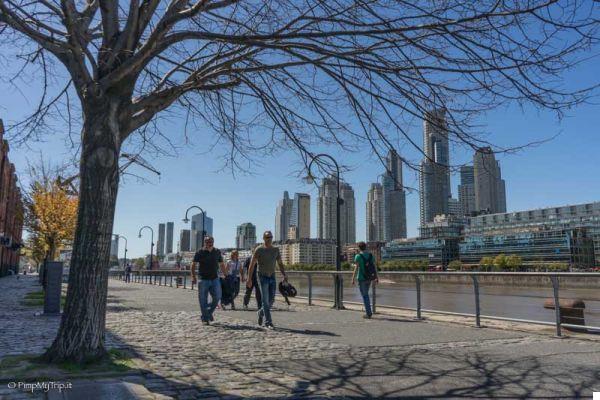
Walk to Puerto Madero and the financial district of Buenos Aires in the background
The old abandoned port is gone. In its place today is one of the coolest neighborhoods in Buenos Aires, with very expensive lofts, offices, restaurants of the highest level (and price) and surveillance cameras.
The port was built by the engineer Madero, but its construction lasted much longer than expected and when it was inaugurated it was already obsolete. After a few years it was completely abandoned until 1989 when it was decided to rebuild and recover the area.
Today the riverside is a succession of trendy clubs and bars and luxury apartments built inside the old renovated buildings of the early twentieth century: Puerto Madero it is one of the most expensive neighborhoods in the whole city and a great place to spend your evenings in the midst of the cream of the movida porteña.
1 - The Bridge of Women
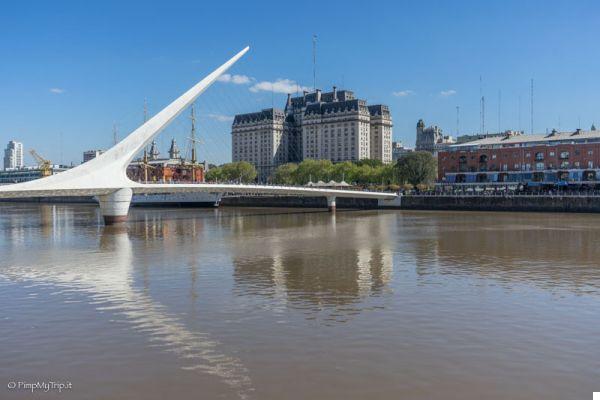
El Puente de La Muyer represents a couple dancing tango, but for me it takes imagination to imagine it!
Designed by the Spanish architect Santiago Calatrava and given to the city by the impresario Alberto Gonzalez, the Bridge of the Muyer it quickly turned into one of the symbols of Buenos Aires.
Inaugurated in 2001 in the midst of the economic crisis in Argentina (for what they immediately did not run and they had their good reasons), the bridge has two fixed sections and a mobile one that rotates on a concrete pillar thus allowing the passage of boats.
The project is a modernist work that represents a couple of tango dancers and the curve represents the silhouette of the woman's profile: let me tell you, it takes a great imagination to even be able to imagine it.
Beside the Puente is anchored the Sarmiento frigate, the training ship for the cadets of the Argentine Army from 1897 to 1938. The ship retains guns and original furniture. It can be visited every day from 9:00 to 20:00.
2 - South Black Coast Ecological Reserve
it's quite amazing how in the middle of a city of 200 square kilometers, you can find a place like this. There South Coast Ecological Reserve are about 400 hectares of green space on the river bank just a stone's throw from the financial center of the city with modern and very tall skyscrapers.
The reserve is a real ecosystem in which various types of natural environments with various plants and animals have formed.
The reserve has a perimeter path of 8 km that can be easily covered on foot or by bicycle.
3 - Faena Arts Center
This Museum of Contemporary Art, apparently the most beautiful in the whole city, has been set up inside an old factory that has been renovated and converted.
The main hall of the Museum is the old machine room of the factory whose details recall the past.
I haven't visited this one either. With all the museums in Buenos Aires and the limited time available, you have to have the courage to make choices.
But the Faena Arts Center is one of the many reasons why I will return to the capital of Argentina.
Palermo
Many of its inhabitants decided to sell their houses in the Palermo neighborhood because the prices were high and there were good deals.
They left and probably did a lot of harm.
Today Palermo is constantly exploding: every day new restaurants, new art galleries, new clubs, new cinema and television studios are born: in short, Palermo has already been defined as one of the coolest neighborhoods in Latin America and not by chance.
1 - Alto Palermo
One of the largest shopping malls in all of Buenos Aires, theAlto Palermo it was set up where a brewery used to be.
Opened in 1990 today it has more than 150 stores and (some will rejoice) here is the first Starbucks in Baires!
2 - Palermo Hollywood
On the other side of Juan B. Justo, right between Santa Fe Dorrego and Niceto Vega streets, Palermo Hollywood it occupies “only” 63 blocks. The name has been given to the television stations, independent producers and radio stations that find a home here.
Compared to other streets in Palermo, here there are fewer shops for things to dress but more bars and clubs where to spend a few hours.
Il Niceto club it is not to be missed in the evening because deejays from all over the world come here to play. However, the shows start late, so keep in mind that the next morning you will sleep late!
3 - Palermo Soho
Palermo Soho it is the part of the neighborhood closest to Cordoba Avenue. Its center is Plaza Serrano or rather Plaza Julio Cortazar called Plaza Serrano.
Plaza Serrano is an oval square surrounded by clubs, restaurants and clubs. A market is also set up here, but to be honest it is not that I personally have exalted it and I do not know whether to recommend it to you.
Park of Palermo (Bosques de Palermo)
The official name would be Tres de Febrero Park, but the Porteños call it Palermo woods.
Just ten minutes outside the center of Buenos Aires is this large green area of 80 hectares, with more than 12,000 trees, 194 bird species, rose gardens and a path full of sculptures… and entry is free!
Like Hyde Park in London and Central Park in New York, Les Bosques in Palermo is not only the green lung of the city, but a place to go to read a book, relax on a lawn, take a walk and it is one of the places that make the inhabitants of the city happier.
If you have time, a tour is a must.
4 - Museum of Evita Peròn
Opened in 2002 for the 50th anniversary of the death of Evita Peròn, this small but interesting museum it was one of the things I liked the most about Buenos Aires.
She is in a beautiful house which, unlike what I thought, was not the house in which Evita lived, but a children's shelter that she herself founded during the years of her government (or rather her husband's government).
Inside are Evita's books, objects, photos and videos and even a gallery with the clothes she used during her travels and public appearances.
Unfortunately, it is not possible to photograph inside.
Visit: open from Tuesday to Sunday, from 11:00 to 19:00
5 – Generic Floralis
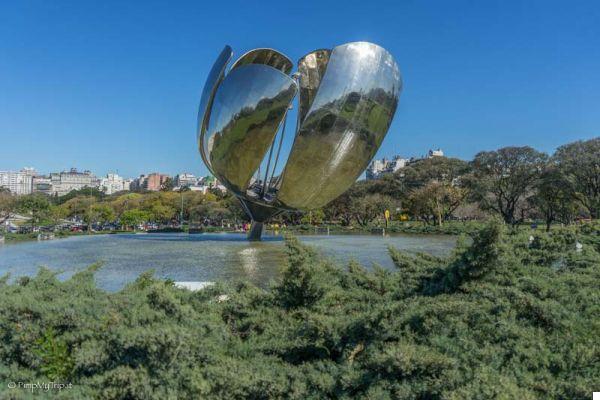
Floralis Generica petals should open every morning and close every evening
A large sculpture in stainless steel in the shape of a flower which, thanks to an electric system, opens its petals in the morning and closes them in the evening.
According to its creator this is a symbol of hope, which is reborn every day.
Given to the city by the artist Eduardo Catalano, it is located in a large lawn and is one of the symbols of Buenos Aires.
Although it is located in the Palermo district, to tell the truth it is located exactly behind the National Museum of Fine Arts (Recoleta district) and next to theUniversity of Law of Buenos Aires.
Recoleta
One of the residential districts of the city, Recoleta is most famous for its cemetery (Cementerio della Recoleta) and for the National Library of the Argentine Republic, the most important in the whole country.
A nice market also comes to life on Sundays.
1 - Recoleta Cemetery
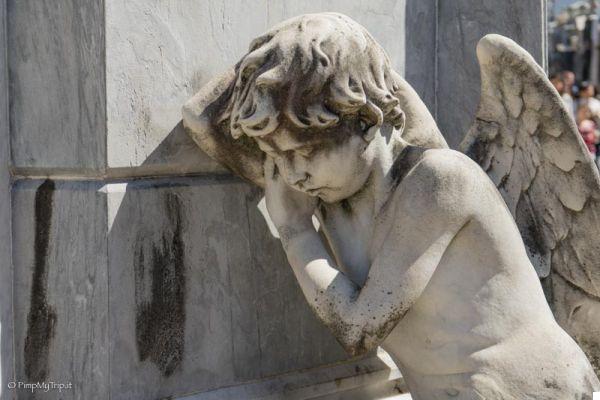
The Cementerio de la Recoleta, although it is very touristy, is a place that should be respected and it is therefore necessary to behave appropriately
Inaugurated on November 17, 1822, the Recoleta Cemetery in addition to being the first public cemetery in the city, it is also the historical and artistic monument of the whole of Argentina.
Here, in the midst of statues and monumental tombs, the greatest personalities of Argentine history rest: politicians, soldiers, artists, composers, poets, explorers lie honored every day by the presence of thousands of Argentines and foreign tourists.
Here is also the tomb of Evita Peròn.
Even if it is also a touristy place in a certain sense, never forget that it is above all a place to which respect must be given, so try to avoid noisy behaviors and above all not in keeping with its sacredness.
Admission is free and is open every day from 7:00 to 18:00.
2 - National Museum of Fine Arts
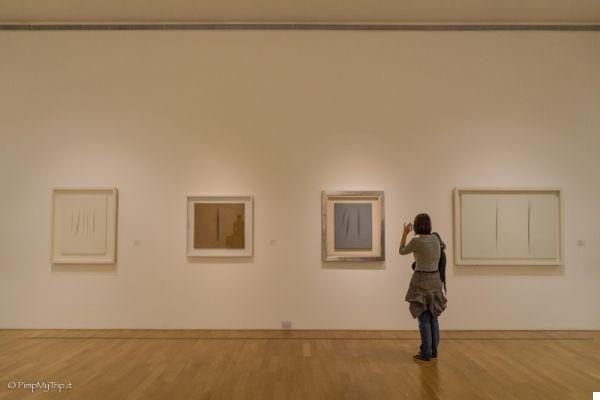
The exhibition of Lucio Fontana at the National Museum of Fine Arts
Not far from the Recoleta cemetery the small but interesting National museum of fine arts worth a visit. Admission is free and various works are exhibited including beautiful paintings by Monet, Renoir and Van Gogh.
There are also temporary exhibitions, when I went there were the works of Lucio Fontana on display.
Other Things to See in Buenos Aires
The things to see listed up to here are the most famous and interesting in the whole city.
But if you have time you can also dedicate yourself to these on other days.
1 - Museum of Memory (ex ESMA)
La ESMA (Escuela de Mecánica de la Armada) was a school for the training of officers of the Argentine Navy but is sadly famous for another reason: it was one of the more than 300 illegal detention and torture centers of the Desaparecidos during the military dictatorship.
Al Selenium (the codename of ESMA during the Dirty War) those who were even suspected of going against the dictatorial regime or who were considered "uncomfortable" were brought.
Here they were brutally tortured for days before being put on board flights of death. Of the more than 5.000 "dissidents" brought here very few have come out alive, freed to be living testimony of what would happen to those who rebelled against the dictatorship.
Today it has become a Museum of Memory, to remember the brutalities and crimes of the dictatorship and for the promotion and defense of human rights.
2 - Tiger and river delta
Tigre is a small town located about 30 km from Buenos Aires. 30 km are not many, but it seems to be totally catapulted into another world.
The geography of the delta of the Parana River that plunges into the Rio de la Plata, the trees and flowers give the feeling that time passes slowly.
The trip takes about a day: starting from Buenos Aires and reaching Tigre by boat along the river, you can make the visit and return to the city around 18:00.
You can book the tour to Tigre by boat on the Civitatis website
What to see around Buenos Aires
I have already told you about El Tigre which is a day trip absolutely not to be missed when visiting Buenos Aires.
But there are other beautiful excursions to do and things to see around Buenos Aires that I absolutely recommend:
1 - Colonia de Sacramento
Located in front of the Rio de La Plata, Colonia de Sacramento it is a short ferry ride from Buenos Aires.
This picturesque city is characterized by its cobbled streets and lots of colonial buildings, not surprisingly the historic district of Colonia de Sacramento is a UNESCO World Heritage Site.
The landmark and what Colonia de Sacramento is famous for is the Field Gate.
Not only is the Portón de Campo an iconic city gate, but it features a perfectly preserved wooden drawbridge.
Il Portuguese Museum it houses dozens of Portuguese settler artifacts; everything from weapons to traditional clothing.
2 - La Plata
La Plata is the capital of the province of Buenos Aires which surrounds the city of Buenos Aires.
If you want to take an easy day trip from Buenos Aires with the kids, La Plata is an easy option with attractions that will keep everyone entertained.
Founded in 1870, the city is based on a grid system which has led it to be labeled as the "City of Diagonals".
The tree-lined streets are a fantastic place to stroll to admire architecture with a European flavor, including one Neo-Gothic cathedral, one of the oldest in the country, and a fantastic natural history museum.
The best thing about La Plata for children though is rightly called the Republic of Children.
Il theme park, on the outskirts of the city, it is a wonder for the little ones and is complete with a child-friendly parliament, port, airport, church and hotel.
3 - Montevideo
From capital to capital, you should definitely consider taking the day trip from Buenos Aires to Montevideo, the capital of Uruguay, and insert another country in your Argentine adventure.
My friend Carolina from Buenos Aires literally goes crazy for this trip!
Plus, it's an easy ferry ride across the gigantic Rio de La Plata to Montevideo, making this day trip from Buenos Aires even easier than you'd expect.
The setting of the capital of Uruguay is something that must be seen; it is almost entirely surrounded by beaches.
Founded in 1724, Montevideo is full of beautiful buildings. Embarking on a walking tour of the city is a great way to get around and see what architectural gems it has to offer.
La Old City - or Old Town - is the most interesting part, where you will find everything from Art Deco buildings to old colonial houses.
Famous landmarks include the Neoclassical Solís Theater and the imposing Salvo Palace.
4 - Mataderos Fair
We are in Argentina, the country of Jineteada, do you want not to put a bit of rurality into it?
La Mataderos Fair it is an immersive cultural experience that will leave you spellbound.
The Feria de Mataderos, or the fair of matadors, was created 20 years ago within the slaughterhouse district.
The fair sees rural communities enter the suburbs to keep their culture alive; to show off their traditional clothes, their kitchens and home-made goods.
Stroll the streets lined with stalls selling everything from tamales to locro, from fine wines to local crafts.
You can combine a visit to the Feria de Mataderos with a tour of the Criollo de los Corrales Museum which offers fascinating insights into life in the Pampas.
Where to sleep in Buenos Aires
In my opinion the best place to sleep in Buenos Aires is the Microcentro and especially on the Avenida de Mayo.
In addition to the fact that the accommodation offers they are varied and for all tastes, this is the closest neighborhood to many of the things to see and is full of theaters, clubs, bars and restaurants.
In my opinion these are among the best choices:
- Portal del Sur Hostel: a beautiful hostel, with a choice of double and single rooms and with private bathroom. It has a comfortable common room and a nice rooftop bar! Free wi-fi connection and excellent location a stone's throw from Plaza De Mayo and 9 de Julio Avenue.
- Exe Hotel Colòn: an excellent hotel a stone's throw from the Colòn theater. One of the favorite choices on Booking.com.
- Own Recoleta: a little more expensive this hotel is also a great choice. Located in the heart of Buenos Aires, it offers free breakfast and wi-fi.
- Broadway Hotel & Suites: what more could you want than a panoramic rooftop pool? Quite expensive, but they have great last-minute deals on Booking.com and can spend less than 90 euros for two!
- Castelar Hotel & SPA: a hotel with wellness center in the center of Buenos Aires. it is one of the most historic hotels in the city where people like Garcia Lorca have stayed. The rooms could do with a revamp, but the restaurant is great, the location good and the price decent.
Did you like this post? Do you have other tips on what to see in Buenos Aires? If you leave it in the comments, it will be useful for other travelers!
Disclaimer: mine second trip to Argentina was done in collaboration with Aerolineas Argentinas, Lol Travel ed Argentina National Tourist Board. This article about what to see in Buenos Aires it is the result of my personal experience in the city and as always my opinions are personal and sincere.





